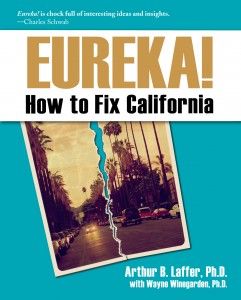Dueling economists debate if CA is ‘back’
by CalWatchdog Staff | June 19, 2013 10:40 am
 [1]June 19, 2013
[1]June 19, 2013
By Wayne Lusvardi
Was it conservative budget austerity or liberal tax hikes that have brought about a “California comeback,”[2] as proclaimed by Gov. Jerry Brown and others? The common view is that tax hikes have brought the recovery and balanced the budget.
For example, Nobel Economics Laureate and New York Times columnist Paul Krugman wrote [3]that, with a Democratic supermajority in the Legislature, Brown is “free to push an agenda of tax hikes and infrastructure spending that sounds remarkably like the kind of thing California used to do before the rise of the radical right.
“And if this agenda is successful, it will have national implications. After all, California’s political story — in which a radicalized G.O.P. fell increasingly out of touch with an increasingly diverse and socially liberal electorate, and eventually found itself marginalized — is arguably playing out with a lag on the national scene too.
“So is California still the place where the future happens first? Stay tuned.”
Los Angeles based free-lance writer David Dayen writes in Salon[4], “How liberals saved California.” Subtitle: “It wasn’t Jerry Brown’s austerity that led the fiscal comeback. It was the state’s smart, bold progressive movement.”
Dayen insists California was rescued when a Democratic Party supermajority took power away from Republicans to pass a budget without opposition. Dayen singles out Brown’s “pro-austerity” bias of cutting $15 billion from health and welfare programs as a failure. “Brown’s asceticism is not something to admire without measuring the dramatic real world effects” from health and dental care cutbacks.
Economists: Tax hikes retard Growth and austerity worked
However, writing in the June 2013 “Economic Letter” of the San Francisco Federal Reserve Bank, senior economist Daniel Wilson and associate Brian Lucking convincingly show that tax hikes, not spending cuts, are likely to suppress economic growth over the next three years. In “Fiscal Headwinds: Is the Other Shoe About to Drop?,”[5] they conclude:
“Surprisingly, despite all the attention federal spending cuts and sequestration have received, our calculations suggest they are not the major contributors to this projected (economic) drag. The excess fiscal drag on the horizon comes almost entirely from raising taxes.”
According to data shown by Wilson and Lucking, taxes as a share of Gross Domestic Product were below the historical trend during the Great Recession. But they project that taxes over the next three years will rise much faster and will slow the economy about 1 percentage point per year. Their research is not specifically about California. Nonetheless, we can reasonably conclude that California’s recent income and sales tax increases, coupled with tax hikes at the local level, will additionally retard state growth.
Furthermore, a report conducted by the Rand Corporation[6] in June 2012 concluded that deregulation and cutbacks of “categorical jobs programs” saved California K-12 schools from 2007 to 2012. In other words, austerity coupled with deregulation worked.
What Comeback?
While there may be a self-proclaimed “comeback” for California’s state budget, this has not extended to the state’s economy, especially for those at the lower end of the occupational ladder. The recent U.C.L.A. Anderson Business School Economic Forecast[7] concluded, “It’s not a recovery. It’s not even normal growth. It’s bad.”
California is still living in budget denial. It is increasing funding for public schools based on a proclaimed economic comeback. However, California’s so-called balanced budget[8] is still running huge deficits for underfunded pensions and retiree health benefits.
Obamacare likely will make things worse. As the Los Angeles Times reported last month[9], “The average premium for individual plans sold through [the private] EHealthInsurance in California last year was $177 a month. Covered California [the state Obamacare scheme] said the average premium for the three lowest Silver plans statewide was $321 a month, albeit for more comprehensive benefits.” That extra money will be taken out of people’s pockets and put into Obamacare, reducing non-government economic activity statewide.
A flat tax would bring prosperity for all
Actually, there is a way out — a way to increase tax revenues while also cutting tax rates.
In his book “Eureka! How To Fix California,”[10] economist Art Laffer cites studies showing that increasing state income taxes slows relative growth. Public pension funds that require nearly 7.5 percent to 7.75 percent annual return are unlikely to be fully funded in a slow-growth California.
Laffer asserts that California gives up $500 billion (with a “b”) per year because of the compound effect of growth-suppressing policies. This is five times the average state general fund budget of about $100 billion per year. Public schools and those dependent on health and welfare programs could benefit from his flat tax proposal.
Laffer proposes scrapping the entire state tax system — income taxes, property taxes, sales taxes, etc. — and replacing it with a simple flat income tax of 5.5 percent. At a minimum, it would reduce accounting costs needed to comply with incredibly complex state tax laws. It also would free immense amounts of capital for investment in new business and jobs creation, greatly broadening the tax base in the bargain. More economic activity means higher tax collections, without higher tax rates.
With the “California comeback” supposedly advancing at a fast clip, action on Laffer’s idea is unlikely now. But during the next recession, when California obviously no longer is “back,” but once again down and out, his ideas will be worth trying.
- [Image]: http://www.calwatchdog.com/2012/03/26/jerry-brown-governor-13/eurekafrontcover_final/
- “California comeback,”: http://articles.latimes.com/2013/jan/24/news/la-ol-california-jerry-brown-20130124
- Paul Krugman wrote : http://www.nytimes.com/2013/04/01/opinion/krugman-lessons-from-a-comeback.html?hp&_r=0
- writes in Salon: http://www.salon.com/2013/05/31/how_liberals_saved_california/
- “Fiscal Headwinds: Is the Other Shoe About to Drop?,”: http://www.frbsf.org/economic-research/publications/economic-letter/2013/june/fiscal-headwinds-federal-budget-policy/
- Rand Corporation: http://www.rand.org/pubs/technical_reports/TR1229.html
- U.C.L.A. Anderson Business School Economic Forecast: http://www.latimes.com/business/la-fi-ucla-forecast-20130605,0,7676874.story
- balanced budget: http://politicaloutcast.com/2013/03/democrats-balanced-budget-still-results-in-huge-deficits/
- reported last month: http://articles.latimes.com/2013/may/23/business/la-fi-calif-health-rates-20130524
- “Eureka! How To Fix California,”: http://www.amazon.com/Eureka-How-California-Arthur-Laffer/dp/1934276189
Source URL: https://calwatchdog.com/2013/06/19/dueling-economists-debate-if-ca-is-back/